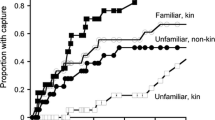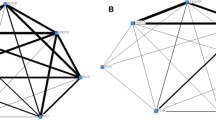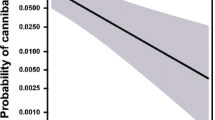Abstract
For potentially cannibalistic animals such as spiders, the ability to recognize and avoid kin and/or preferentially cannibalize non-relatives would permit exploiting conspecifics as prey while minimizing loss of inclusive fitness. We investigated the effects of relatedness and availability of alternative food on cannibalism tendency in pairs of juvenile Hogna helluo (Walckenaer), a North American wolf spider (Araneae: Lycosidae). For second-instar spiderlings (dispersing stage), cannibalism was more likely among pairs of non-sibs than pairs of sibs and, interestingly, was also more likely when other prey were available. We found no evidence of increased cannibalism in pairings involving broods of greatest average size disparity, indicating that size differences are unlikely to explain differences in cannibalism tendency. Additionally, the relative number of deaths from cannibalism or other causes did not increase with increasing risk of starvation. For third-instar spiderlings, which had lived independently of their mother and sibs following dispersal, cannibalism rates were very high in all treatments and there were no significant effects of relatedness or food availability. Our results suggest that spiders with predominantly solitary lifestyles may bias cannibalism toward non-kin during the juvenile associative period, and that this effect is lost in the subsequent instar. Results are discussed in the context of several potential mechanisms that might result in differential cannibalism.


Similar content being viewed by others
References
Anderson JF (1974) Responses to starvation in the spiders Lycosa lenta Hentz and Filistata hibernalis (Hentz). Ecology 55:576–585
Andrade MCB (1996) Sexual selection for male sacrifice in the Australian redback spider. Science 271:70–72
Andrade MCB (1998) Female hunger can explain variation in cannibalistic behavior despite male sacrifice in redback spiders. Behav Ecol 9:33–42
Anthony CD (2003) Kinship influences cannibalism in the wolf spider, Pardosa milvina. J Insect Behav 16:23–36
Arnqvist G, Henriksson S (1997) Sexual cannibalism in the fishing spider and a model for the evolution of sexual cannibalism based on genetic constraints. Evol Ecol 11:255–273
Bilde T, Lubin Y (2001) Non-kin biased cannibalism in a subsocial spider. J Evol Biol 14:959–966
Conover RJ (1966) Factors affecting the assimilation of organic matter by zooplankton and the question of superfluous feeding. Limnol Oceanogr 11:346–354
Crespi BJ (1992) Cannibalism and trophic eggs in subsocial and eusocial insects. In: Elgar MA, Crespi BJ (eds) Cannibalism: ecology and evolution among diverse taxa. Oxford University Press, New York, pp 176–213
Dong Q, Polis GA (1992) The dynamics of cannibalistic populations: a foraging perspective. In: Elgar MA, Crespi BJ (eds) Cannibalism: ecology and evolution among diverse taxa. Oxford University Press, New York, pp 13–37
Dou S, Seikai T, Tsukamoto K (2000) Cannibalism in Japanese flounder juveniles, Paralichthys olivaceus, reared under controlled conditions. Aquaculture 182:149–159
Edgar WD (1969) Prey and predators of the wolf spider Lycosa lugubris. J Zool Lond 159:405–411
Elgar MA (1992) Sexual cannibalism in spiders and other invertebrates. In: Elgar MA, Crespi BJ (eds) Cannibalism: ecology and evolution among diverse taxa. Oxford University Press, New York, pp 128–155
Elgar MA, Crespi BJ (1992) Ecology and evolution of cannibalism. In: Elgar MA, Crespi BJ (eds) Cannibalism: ecology and evolution among diverse taxa. Oxford University Press, New York, pp 1–12
Elwood R (1992) Pup-cannibalism in rodents: causes and consequences. In: Elgar MA, Crespi BJ (eds) Cannibalism: ecology and evolution among diverse taxa. Oxford University Press, New York, pp 299–322
Evans TA (1999) Kin recognition in a social spider. Proc R Soc Lond B 266:287–292
Evans TA, York-Main B (1993) Attraction between social crab spiders: silk pheromones in Diaea socialis. Behav Ecol 4:99–105
Fletcher DJC (1987) The behavioral analysis of kin recognition: perspectives on methodology and interpretation. In: Fletcher DJC, Michener CD (eds) Kin recognition in animals. Wiley, Chichester, pp 19–54
Foelix RF (1996) Biology of spiders, 2nd edn. Oxford University Press, New York
Greenstone MH (1978) The numerical response to prey availability of Pardosa ramulosa (McCook) (Araneae: Lycosodae) and its relationship to the role of spiders in the balance of nature. Symp Zool Soc Lond 42:183–193
Greenstone MH (1979) Spider behaviour optimises dietary essential amino acid composition. Nature 282:501–503
Gundermann JL, Horel A, Krafft B (1993) Experimental manipulations of social tendencies in the subsocial spider, Coelotes terrestris. Insect Soc 40:219–229
Hallander H (1970) Prey, cannibalism and microhabitat selection in the wolf spiders Pardosa chelata O. F. Müller and P. pullata Clerck. Oikos 21:337–340
Hauber ME, Sherman PW (2000) The armpit effect in hamster kin recognition. Trends Ecol Evol 15:349–350
Hepper PG (1991) Recognizing kin: ontogeny and classification. In: Hepper PG (ed) Kin recognition. Cambridge University Press, Cambridge, pp 259–288
Jackson RR (1980a) Cannibalism as a factor in the mating strategy of the jumping spider Phidippus johnsoni (Araneae, Salticidae). Bull Br Arachnol Soc 5:129–133
Jackson RR (1980b) Comparative studies of Dictyna and Mallos. V. Tolerance and resistance to starvation. Psyche 87:211–220
Jackson RR (1987) Comparative study of releaser pheromone associated with the silk of jumping spiders (Araneae, Salticidae). N Z J Zool 14:1–10
Jackson RR, Pollard S (1997) Jumping spider mating strategies: sex among cannibals in and out of webs. In: Choe JC, Crespi BJ (eds) The evolution of mating systems in insects and arachnids. Cambridge University Press, Cambridge, pp 340–351
Johnson JC (2001) Sexual cannibalism in fishing spiders (Dolomedes triton): an evaluation of two explanations for female aggression towards potential mates. Anim Behav 61:905–914
Jones JS (1982) Of cannibals and kin. Nature 299:202–203
Jones TC, Parker PG (2002) Delayed juvenile dispersal benefits both mother and offspring in the cooperative spider Anelosimus studiosus (Araneae: Theridiidae). Behav Ecol 13:142–148
Kim KW (2000) Dispersal behaviour in a subsocial spider: group conflict and the effect of food availability. Behav Ecol Sociobiol 48:182–187
Kim KW, Horel A (1998) Matriphagy in the spider Amaurobius ferox (Araneidae, Amaurobiidae): an example of mother-offspring interactions. Ethology 104:1021–1037
Kim KW, Roland C, Horel A (2000) Functional value of matriphagy in the spider Amaurobius ferox. Ethology 106:729–742
Klahn JE, Gamboa GJ (1983) Social wasps: discrimination between kin and nonkin brood. Science 221:482–484
Komdeur J, Hatchwell BJ (1999) Kin recognition: function and mechanism in avian societies. Trends Ecol Evol 14:237–241
Krafft B, Horel A, Julita J-M (1986) Influence of food supply on the duration of the gregarious phase of a maternal-social spider, Coelotes terrestris (Araneae, Agelenidae). J Arachnol 14:219–226
Lindstrom K, Sargent RC (1997) Food access, brood size, and filial cannibalism in the fantail darter, Etheostoma flabellare. Behav Ecol Sociobiol 40:107–110
Maupin JL, Riechert SE (2001) Superfluous killing in spiders: a consequence of adaptation to food-limited environments? Behav Ecol 12:569–576
Miller GL (1989) Subsocial organization and behavior in broods of the obligate burrowing wolf spider Geolycosa turricola (Treat). Can J Zool 67:819–824
Nossek ME, Rovner JS (1984) Agonistic behavior in female wolf spiders (Araneae, Lycosidae). J Arachnol 11:407–422
Oelbermann K, Scheu S (2002) Effects of prey type and mixed diets on survival, growth and development of a generalist predator, Pardosa lugubris (Araneae: Lycosidae). Basic Appl Ecol 3:285–291
Olsen KH (1992) Kin recognition in fish mediated by chemical cues. In: Hara TJ (ed) Fish chemoreception. Chapman and Hall, London, pp 229–248
Panek LM, Gamboa GJ (2000) Queens of the paper wasp Polistes fuscatus (Hymenoptera: Vespidae) discriminate among larvae on the basis of relatedness. Ethology 106:159–170
Pfennig DW (1997) Kinship and cannibalism: understanding why animals avoid preying on relatives offers insights into the evolution of social behaviour. BioScience 47:667–675
Pfennig DW, Reeve HK, Sherman PW (1993) Kin recognition and cannibalism in spadefoot toad tadpoles. Anim Behav 46:87–94
Pfennig DW, Sherman PW, Collins JP (1994) Kin recognition and cannibalism in polyphonic salamanders. Behav Ecol 5:225–232
Polis G (1981) The evolution and dynamics of intraspecific predation. Annu Rev Ecol Syst 12:225–251
Pourie G, Trabalon M (1999) Agonistic behaviour of female Tegenaria atrica in the presence of different aged spiderlings. Physiol Entomol 24:143–149
Riechert SE (1981) The consequences of being territorial: spiders, a case study. Am Nat 117:871–892
Riechert SE, Harp JM (1987) Nutritional ecology of spiders. In: Slansky F, Rodriguez JG (eds) Nutritional ecology of insects, mites and spiders. Wiley, New York, pp 645–672
Ruttan LM (1990) Experimental manipulations of dispersal in the subsocial spider, Theridion pictum. Behav Ecol Sociobiol 27:169–173
Rypstra AL (1986) High prey abundance and a reduction in cannibalism: the first step to sociality in spiders (Arachnida). J Arachnol 14:193–200
Sadler LM, Elgar MA (1994) Cannibalism among amphibian larvae: a case of good taste. Trends Ecol Evol 9:5–6
Samu F, Toft S, Kiss B (1999) Factors influencing cannibalism in the wolf spider Pardosa agrestis (Araneae, Lycosidae). Behav Ecol Sociobiol 45:349–354
Sasaki T, Iwahashi O (1995) Sexual cannibalism in an orb-weaving spider Argiope aemula. Anim Behav 49:1119–1121
Schausberger P, Croft BA (2001) Kin recognition and larval cannibalism by adult females in specialist predaceous mites. Anim Behav 61:459–464
Schneider JM (1995) Survival and growth in groups of a subsocial spider (Stegodyphus lineatus). Insect Soc 42:237–248
Schneider JM (1996) Food intake, growth and relatedness in the subsocial spider, Stegodyphus lineatus (Eresidae). Ethology 102:386–396
Schneider JM, Lubin Y (1996) Infanticidal male eresid spiders. Nature 381:655–656
Schneider JM, Lubin Y (1997) Infanticide by males in a spider with suicidal maternal care, Stegodyphus lineatus (Eresidae). Anim Behav 54:305–312
Searcy LE, Rypstra AL, Persons MH (1999) Airborne chemical communication in the wolf spider Pardosa milvina. J Chem Ecol 25:2527–2533
Seibt U, Wickler W (1987) Gerontophagy versus cannibalism in the social spiders Stegodyphus mimosarum Pavesi and Stegodyphus dumicola Pocock. Anim Behav 35:1903–1904
Tang-Martinez Z (2001) The mechanisms of kin discrimination and the evolution of kin recognition in vertebrates: a critical re-evaluation. Behav Process 53:21–40
Taylor PW (1998) Dragline-mediated mate-searching in Trite planiceps (Araneae, Salticidae). J Arachnol 26:330–334
Taylor PW, Jackson RR (1999) Habitat-adapted communication in Trite planiceps, a New Zealand jumping spider (Araneae, Salticidae). N Z J Zool 26:127–154
Tietjen WJ (1979a) Tests for olfactory communication in four species of wolf spiders (Araneae, Lycosidae). J Arachnol 6:197–206
Tietjen WJ (1979b) Is the sex pheromone of Lycosa rabida (Araneae: Lycosidae) deposited on a substratum? J Arachnol 6:207–212
Toft S, Wise DH (1999a) Growth, development and survival of a generalist predator fed single- and mixed-species diets of different quality. Oecologia 119:191–197
Toft S, Wise DH (1999b) Behavioral and ecophysiological responses of a generalist predator to single- and mixed-species diets of different quality. Oecologia 119:198–207
Trabalon M, Bagneres AG, Hartmann N, Vallet AM (1996) Changes in cuticular compounds composition during the gregarious period and after dispersal of the young in Tegenaria atrica (Araneae, Agelenidae). Insect Biochem Mol Biol 26:77–84
Uetz GW, Bischoff J, Raver J (1992) Survivorship of wolf spiders (Lycosidae) reared on different diets. J Arachnol 20:207–211
Wagner JD (1995) Egg sac inhibits filial cannibalism in the wolf spider, Schizocosa ocreata. Anim Behav 50:555–557
Wagner JD, Wise DH (1996) Cannibalism regulates densities of young wolf spiders: evidence from field and laboratory experiments. Ecology 77:639–652
Wagner JD, Wise DH (1997) Influence of prey availability and conspecifics on patch quality for a cannibalistic forager: laboratory experiments with the wolf spider Schizocosa. Oecologia 109:474–482
Walker SE, Marshall SD, Rypstra AL, Taylor DH (1999) The effects of hunger on locomotory behaviour in two species of wolf spider (Araneae, Lycosidae). Anim Behav 58:515–520
Walls SC, Roudebush RE (1991) Reduced aggression toward siblings as evidence of kin recognition in cannibalistic salamanders. Am Nat 138:1027–1038
Yeargan KV (1975) Prey and periodicity of Pardosa ramulosa (McCook) in alfalfa. Environ Entomol 4:137–141
Zar JH (1999) Biostatistical analysis. Prentice-Hall, New Jersey, pp 486–515
Acknowledgements
For financial support during this research, we thank the National Science Foundation (grant IBN 9906446 to G.W.U.); P.W.T. was awarded a University of Cincinnati post-doctoral fellowship. We are grateful to the Cincinnati Nature Center, Rowe Woods, for permission to collect spiders on their property. Kelly Roberts provided invaluable assistance with rearing and maintenance of spiders and staging of experiments. We are especially grateful to Trine Bilde and Yael Lubin for access to their previously unpublished data. We appreciate the editorial comments of Mark Elgar, Casey Harris, Jerald Hinn, Bruce Jayne, Scott Sakaluk, Sean Walker, and three anonymous reviewers. The work presented here adheres to all relevant laws and guidelines pursuant to the use of invertebrates in research in the United States of America.
Author information
Authors and Affiliations
Corresponding author
Additional information
Communicated by M. Elgar
Rights and permissions
About this article
Cite this article
Roberts, J.A., Taylor, P.W. & Uetz, G.W. Kinship and food availability influence cannibalism tendency in early-instar wolf spiders (Araneae: Lycosidae). Behav Ecol Sociobiol 54, 416–422 (2003). https://doi.org/10.1007/s00265-003-0646-8
Received:
Revised:
Accepted:
Published:
Issue Date:
DOI: https://doi.org/10.1007/s00265-003-0646-8




